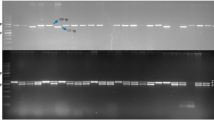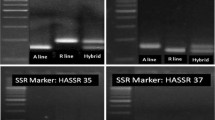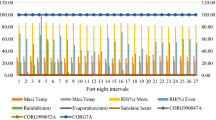Abstract
AFLP technique was used to analyse the polymorphism between rice cytoplasmic male sterility (CMS) line Jin2A and its maintainer Jin2B. A stable differential band was discovered, and sequence analysis showed that Jin2A contained a more tandem repeat of 6 base pairs (AGAAAA) than Jin2B. Further studies confirmed that the diversity came from cpDNA and occurred at three kinds of abortive cytoplasmic genotypes. Accordingly, specific primers were designed and utilized to assess the purity of rice CMS lines during multiplication with pollen fertility and seed setting rates of bagged panicles as control. The result indicated that this cpDNA locus could be utilized to precisely distinguish maintainer plants from rice CMS lines. PCR analysis was consistent with that from Grow-out test in CMS line seed purity assessment during multiplication, despite it was helpless in distinguishing F1 hybrids from CMS lines due to similar cytoplasms. Because of fewer hybrid and more maintainer off-plants, this cpDNA locus was still appropriate for seed purity assessment of rice CMS line during multiplication. This is first report that a marker on cpDNA could be utilized to assess the genetic purity of rice CMS lines with three abortive cytoplasmic genotypes.
Similar content being viewed by others
References
Akagi H, Nakamura A, Sawada R, Oka M, Fujimura T (1995) Genetic diagnosis of cytoplasmic male sterile hybrid plants of rice. Theor Appl Genet 90:948–951
Chen H, Qian Q, Zhu LH, Min SHK, Chen ML (1996) Application of RAPD markers for the seed purity examination of a hybrid rice, Shanyou63. Chin Sci Bull 41(9):833–836
Hanson MR (1991) Plant mitochondrial mutations and male sterility. Annu Rev Genet 25:461–486
He GH, Pei Y, Yang GW, Tang M, Hou L, Yang ZhL, Li YH (2002) AFLP markers of restoring genes of the wild-abortive hybrid rice. Acta Genet Sin 27(4):304–310
He GH, Hou L, Luo XY, Xiao YH, Niu GQ, Yang GW, Pei Y (2003) A common sequence difference between cytoplasmic male sterile lines and their maintainer lines existing in rice (Oryza sativa L.) chloroplast tRNA-Leu gene region. Euphytica 131(3):269–274
Hong DL, Masahiko I (2002) RAPD markers from mitochondrial DNA can distinguish male sterile and fertile cytoplasms in rice (Oryza sativa L.). Acta Agron Sin 28(3):315–320
Hou L, Yang GW, He GH, Tang B, Xiao YH, Pei Y (2000) AFLP markers and sequence analysis in rice cytoplasmic male sterility line, Zhenshan97A, and its maintainer line. Acta Bot Sin 42(6):591–594
Jena KK, Pandey SK (1999) DNA markers for purification of A and B lines for hybrid rice improvement. Hybrid Rice News Lett 2(1):13–14
Laser KD, Lersten NR (1972) Anatomy and cytology of microsporogenesis in cytoplasmic male sterile angiosperms. Bot Rev 38:425–454
Li JZH, He P, SHG Li, Lu RL, Zhu LH (2000) Application of microsatellite markers for the seed purity examination of a hybrid rice, Gangyou22. Chin J Biotechnol 16(2):211–214
Lu ZM, Hong DL (1999) Advance in hybrid rice seed production techniques. In: Basra AS (ed) Heterosis and hybrid seed production in agronomic crops. Food products press, an imprint of the Haworth Press, Inc., New York, pp 65–79
Masahiko I, Hong DL, Yoshinori O, Chang MZh, Taketa S (2003) Characterization of CMS and maintainer lines in indica rice (Oryza sativa L.) based on RAPD marker analysis. Euphytica 129(2):249–252
Mocouch SR, Kohert G, Yu ZH, Wang GS, Khush GS, Coffman WR, Tanksley SD (1988) Molecular mapping of rice chromosomes. Theor Appl Genet 76:815–829
Nandakumar N, Singh AK, Sharma RK, Mohapatra T, Prabhu KV, Zaman FU (2004) Molecular fingerprinting of hybrids and assessment of genetic purity of hybrid seeds in rice using microsatellite markers. Euphytica 136(3):257–264
Sang XCh, He GH, Zhang Y, Yang ZhL, Pei Y (2003) The simple gain of the templates of rice genomes DNA for PCR. HEREDITAS (Beijing) 25(6):705–707
Schnable PS, Wise RP (1998) The molecular basis of cytoplasmic male sterility and fertility restoration. Trends Plant Sci 3:175–180
Virmani SS (1999) Exploitation of heterosis for shifting the yield frontier in rice. In: Croors JG, Pandey S (eds) The genetics and exploitation of heterosis in crops. CIMMYT, ASA, CSSA, Madison, WI, pp 423–438
Wang FG, Zhao JR, Guo JL, She HD, Liu LZh (2004) An improved PAGE/rapid silver staining method used in maize SSR marker. J Agric Biotechnol 12(5):605–607
Xiang TH, Wang XF, Li L, Wu JD, Yang JB (2000) Identification of rice hybrids (Shanyou63, Shanyou64 and Shanyouwan3) and their parents using RAPD markers. Acta Agron Sin 26(3):292–296
Yashitola J, Sundaram RM, Biradar SK, Thirumurugan T, Vishnupriya MR, Rajeshwari R, Viraktamath BC, Sarma NP, Sonti RV (2004) A sequence specific PCR marker for distinguishing rice lines on the basis of wild abortive cytoplasm from their cognate Maintainer lines. Crop Sci 44:920–924
Zhou PH, Tan YF, He YQ, Xu CG, Zhang Q (2003) Simultaneous improvement for four quality traits of Zhenshan97A, by molecular marker assisted selection. Theor Appl Genet 106:326–331
Acknowledgments
The study is partially funded by the National Natural Sciences Foundation of China (No. 30200173), National “863” molecular breeding of China and the Key Natural Sciences Foundation Project of Chongqing. Undergraduate student Gong Xiaoping performed partial pollen fertility assessment. Authors show great acknowledgments.
Author information
Authors and Affiliations
Corresponding author
Rights and permissions
About this article
Cite this article
Sang, X., Yang, Z., Zhong, B. et al. Assessment of purity of rice CMS lines using cpDNA marker. Euphytica 152, 177–183 (2006). https://doi.org/10.1007/s10681-006-9196-2
Received:
Accepted:
Published:
Issue Date:
DOI: https://doi.org/10.1007/s10681-006-9196-2




